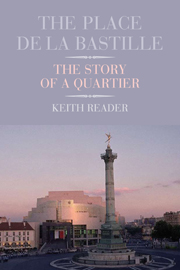Book contents
- Frontmatter
- Contents
- Acknowledgements
- Map by Stephen Ramsay Cartography
- Introduction: The Place de la Bastille
- 1 ‘What's that poor creature doing here?’: the area and the fortress before the Revolution of 1789
- 2 ‘Thought blew the Bastille apart’: the fall of the fortress and the revolutionary years, 1789–1815
- 3 ‘The strategy of the generals of Africa shattered’: the Restoration, Orleanist and Second Republic Years, 1815–1851
- 4 ‘Where is the noise of the storm that I love?’: The Second Empire from Haussmann to the Commune
- 5 ‘Satan's bagpipes’: La Belle Époque's forty-three years of peace
- 6 ‘Villains, stars and everybody in between’: The First War and the entre-deux-guerres
- 7 ‘Slicked hair and splendid sideburns’: Occupation and Liberation
- 8 ‘Let's have some sun!’: post-Gaullism and the Mitterrand years
- 9 ‘A building, not a monument’: the construction of the Bastille Opéra
- 10 ‘A real earthquake’: the impact of the Opéra on the quartier
- 11 Flânerie in the archive: the Faubourg/Bastille today
- Notes
- Bibliography
- Index
6 - ‘Villains, stars and everybody in between’: The First War and the entre-deux-guerres
- Frontmatter
- Contents
- Acknowledgements
- Map by Stephen Ramsay Cartography
- Introduction: The Place de la Bastille
- 1 ‘What's that poor creature doing here?’: the area and the fortress before the Revolution of 1789
- 2 ‘Thought blew the Bastille apart’: the fall of the fortress and the revolutionary years, 1789–1815
- 3 ‘The strategy of the generals of Africa shattered’: the Restoration, Orleanist and Second Republic Years, 1815–1851
- 4 ‘Where is the noise of the storm that I love?’: The Second Empire from Haussmann to the Commune
- 5 ‘Satan's bagpipes’: La Belle Époque's forty-three years of peace
- 6 ‘Villains, stars and everybody in between’: The First War and the entre-deux-guerres
- 7 ‘Slicked hair and splendid sideburns’: Occupation and Liberation
- 8 ‘Let's have some sun!’: post-Gaullism and the Mitterrand years
- 9 ‘A building, not a monument’: the construction of the Bastille Opéra
- 10 ‘A real earthquake’: the impact of the Opéra on the quartier
- 11 Flânerie in the archive: the Faubourg/Bastille today
- Notes
- Bibliography
- Index
Summary
France lost more lives in the First War than any other Allied country bar Russia – almost 1 700 000 – and more than 4 000 000 French soldiers were wounded. I have not been able to find an area-by-area breakdown of these statistics, but it seems reasonable to suppose that the Faubourg suffered as much as other quartiers if not more, given that its largely working-class population would have fought in the trenches rather than enjoying the greater security of an officer's life. The end of the war was marked by victory celebrations on 14 July 1919, in which the far Left alone refused to participate.
The flavour of working life in the Faubourg during this period is evoked in Laurent Azzano's Mes joyeuses années au Faubourg. Azzano came from an Italian family of cabinet-makers installed in the rue de Lappe, and his account – alas short on precise dates – is rich in industrial and social detail, making clear how poor many of the quartier's dwellers were. He evokes the ‘immonde et puante’ / ‘foul and stinking’ Cité Lesage-Bullourde, largely inhabited by poor Jews, where overcrowding and tuberculosis were rife, yet also reminds us of the insurrectionary traditions of the Faubourg whose Auvergnat blacksmiths forged the lances of the Revolution.
- Type
- Chapter
- Information
- The Place de la BastilleThe Story of a Quartier, pp. 89 - 107Publisher: Liverpool University PressPrint publication year: 2011



